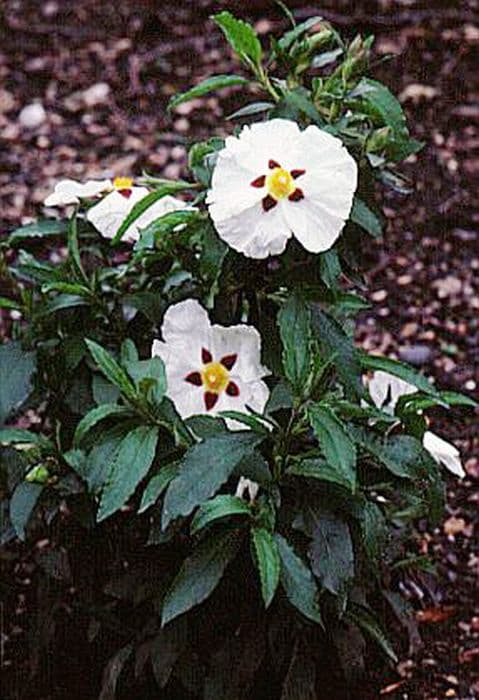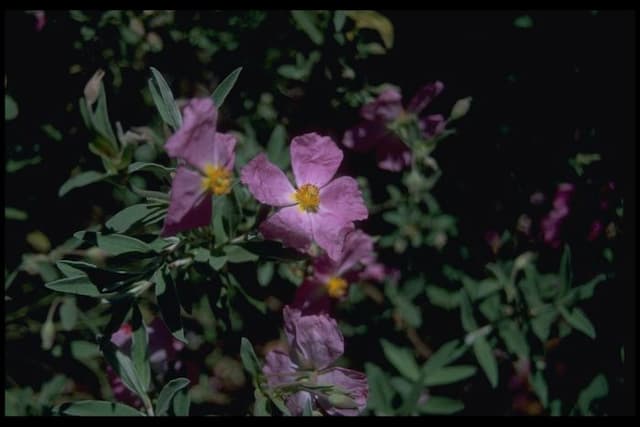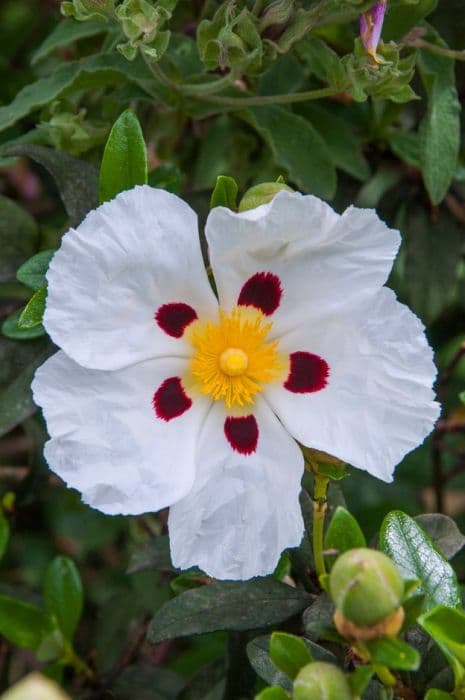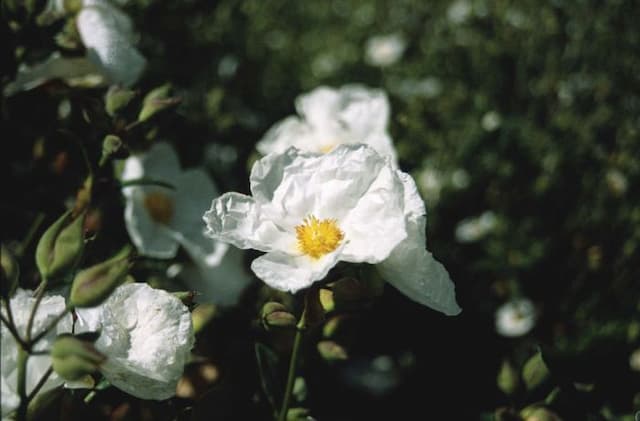Rock Rose Halimium 'Susan'

ABOUT
Halimium 'Susan', often known simply as rockrose, presents a bushy, evergreen habitat with a rounded form. Its small to medium-sized leaves are gray-green, with a fuzzy texture that is soft to the touch. The leaves are arranged in opposite pairs along the stems and sometimes have rolled or curled edges, giving the plant an overall textured and dense appearance. What truly distinguishes rockrose are its flowers, which burst forth in late spring or early summer. The blooms are typically a bright, sunny yellow with a distinct, maroon or deep red spot at the base of each petal. This striking color combination gives the plant a dramatic flair and makes it a standout in garden spaces. Individual flowers are cup-shaped, boasting five wide petals around a central core of numerous stamens, which are often yellowish to golden in hue. As the flowers mature, they create a lovely contrast against the foliage, with the plant often becoming covered in blooms, making it highly attractive to pollinators such as bees and butterflies. The overall appearance of the plant is one of resilience and brightness, ideal for attracting attention in the landscape and lending itself to various garden designs where its ornamental value can be celebrated.
About this plant
 Names
NamesFamily
Cistaceae
Synonyms
Rockrose, Halimium
Common names
Halimium 'Susan'
 Toxicity
ToxicityTo humans
There is limited specific information on the toxicity of Halimium 'Susan', commonly known as rockrose, to humans. Generally, rockroses are not noted for being toxic. However, it is always advisable to exercise caution and avoid ingesting plants that are not confirmed to be edible, as they may cause adverse reactions.
To pets
As with humans, there is limited specific information on the toxicity of Halimium 'Susan', commonly known as rockrose, to pets. Rockroses are not typically listed as toxic to pets. Nonetheless, pet owners should prevent pets from consuming plants that are not known to be safe, as they might cause gastrointestinal upset or other unpredictable reactions.
 Characteristics
CharacteristicsLife cycle
Perennials
Foliage type
Evergreen
Color of leaves
Green
Flower color
Yellow
Height
3 feet (0.91 meters)
Spread
4 feet (1.22 meters)
Plant type
Shrub
Hardiness zones
7
Native area
Mediterranean
Benefits
 General Benefits
General Benefits- Low maintenance: Halimium 'Susan' is known for being a low-maintenance plant, making it suitable for gardeners of all levels.
- Drought tolerance: Once established, it is quite drought-resistant, which can be particularly beneficial in dry or xeriscape gardens.
- Attracts wildlife: The flowers of Halimium 'Susan' are known to attract pollinators such as bees and butterflies, promoting biodiversity.
- Decorative flowers: It produces beautiful yellow blooms, which can add splashes of color to the garden landscape.
- Sun-loving: This plant thrives in full sun, making it an excellent choice for bright and sunny areas.
- Evergreen: As an evergreen shrub, it provides year-round interest and greenery in the garden.
- Landscape versatility: Its size and growth habit make it suitable for various landscaping uses, including borders, rock gardens, and ground cover.
- Wind resistance: Halimium 'Susan' can withstand windy conditions, which is beneficial for coastal or exposed gardens.
 Medical Properties
Medical PropertiesThis plant is not used for medical purposes.
 Air-purifying Qualities
Air-purifying QualitiesThis plant is not specifically known for air purifying qualities.
 Other Uses
Other Uses- Natural Dyes: Halimium 'Susan' can be used to create natural dyes for fabrics. The flowers and leaves may yield various shades depending on the mordant used.
- Fragrant Potpourri: The flowers of Halimium 'Susan', with their light fragrance, can be dried and added to potpourri mixes to provide a gentle aroma to your living spaces.
- Artistic Inspiration: The striking blooms may serve as a subject for botanical illustration or inspire patterns in textile design and other visual arts.
- Photography: With its beautiful flowers, Halimium 'Susan' is an excellent subject for nature photography, particularly in macro photography to capture intricate details.
- Thematic Gardens: It can contribute to the theme of a silver-foliaged garden, providing contrast to other plants with darker foliage.
- Cultural Symbolism: In some cultures, these types of flowering plants can be used during festivals or ceremonies as a symbol of specific emotions or seasons.
- Crafting: Dried flowers can be used in crafting, such as making flower-embedded candles or natural jewelry items like resin pendants.
- Educational Tool: It can be included in educational programs about plant biology, pollination, and plant adaptation to fire-prone environments.
- Companion Planting: Halimium 'Susan' can be used as a companion plant in gardens to provide shelter or a visual backdrop for smaller, less conspicuous plants.
- Garden Scent Layering: Its subtle fragrance can be part of a garden's "scent-scaping," used among other fragrant plants to create a layered aromatic experience.
Interesting Facts
 Feng Shui
Feng ShuiThe Halimium is not used in Feng Shui practice.
 Zodiac Sign Compitability
Zodiac Sign CompitabilityThe Halimium is not used in astrology practice.
 Plant Symbolism
Plant Symbolism- Resilience: Halimium, also known as Rockrose, is known for its ability to thrive in poor soil conditions and resist drought, symbolizing strength and the ability to withstand hardships.
- Beauty: With its bright flowers and attractive form, the Rockrose represents beauty in the natural world, reminding us to appreciate the aesthetics in our surroundings.
- Protection: The Rockrose is part of the Cistaceae family, which includes plants that are adapted to survive wildfires, symbolizing protection and the ability to safeguard oneself from harm.
 Water
WaterThe Rock Rose 'Susan' should be watered deeply but infrequently to mimic its natural dry Mediterranean environment. During the first growing season, establish its root system with regular watering, about once a week, providing approximately one gallon of water per plant each time. Once established, reduce watering frequency, allowing the top inch of soil to dry out between watering sessions. During hot, dry spells, weekly watering may still be necessary, but in cooler or rainy periods, watering can be scaled back or even unnecessary. Always avoid waterlogged soil to prevent root rot.
 Light
LightRock Rose 'Susan' thrives in full sun, where it can receive at least six to eight hours of direct sunlight daily. The best spot for the Rock Rose would be a south-facing garden location where it's exposed to ample sunlight throughout the day. These plants are well adapted to bright conditions and their flowering is optimal when they are in a sun-drenched spot.
 Temperature
TemperatureRock Rose 'Susan' prefers warm climates and can tolerate a wide temperature range. It is hardy and can handle temperatures as low as 15°F but performs best in areas where the temperatures generally stay above freezing. The ideal temperature for this plant is between 60°F and 80°F. Plants may survive brief periods outside of this range, but extended exposure to extreme heat or cold can be detrimental.
 Pruning
PruningPrune the Rock Rose 'Susan' to shape the plant, encourage bushier growth, and remove spent flowers or any dead or damaged branches. The best time for pruning is immediately after the blooming period, typically in late spring or early summer. Pruning at this time allows the plant to set new buds for the next season. It's generally recommended to prune no more than one-third of the plant's size each year.
 Cleaning
CleaningAs needed
 Soil
SoilRock Rose 'Susan' thrives in well-draining soil with a mixture of loam, sand, and peat, at a pH of slightly acidic to neutral, around 6.0 to 7.5.
 Repotting
RepottingRock Rose 'Susan' does not require frequent repotting and can typically be repotted every two to three years to refresh the soil.
 Humidity & Misting
Humidity & MistingRock Rose 'Susan' is tolerant of a wide range of humidity levels and prefers a moderate to low humidity environment, typical of Mediterranean climates.
 Suitable locations
Suitable locationsIndoor
Ensure bright light, minimal water, and well-draining soil for Rock Rose 'Susan'.
Outdoor
Plant in full sun, well-drained soil, and shelter from harsh winds for Rock Rose 'Susan'.
Hardiness zone
7-10 USDA
 Life cycle
Life cycleThe life of Halimium 'Susan', commonly known as rockrose, begins with germination, which is triggered when its seeds are sown in well-draining soil with adequate warmth. After germination, a seedling emerges, developing a root system and initial leaves as it enters the vegetative growth phase. This stage is characterized by rapid growth as the plant develops a sturdy stem and more complex leaf structures to photosynthesize efficiently. Following the juvenile phase, the rockrose enters the flowering stage, producing its distinct yellow flowers that attract pollinators and facilitate sexual reproduction. After pollination, the plant produces seed pods that mature and eventually release seeds, allowing for the dispersal and continuation of the species. As a perennial shrub, Halimium 'Susan' follows this cycle annually, with periods of dormancy typically in the colder months, followed by rebirth in the spring.
 Propogation
PropogationPropogation time
Spring-Early Summer
Propogation: Halimium 'Susan', commonly known as Rock Rose, is generally propagated by semi-ripe cuttings taken in late summer. This popular method involves selecting a healthy, non-flowering shoot of the current year's growth. The cutting should be about 4-6 inches (10-15 cm) long, and the lower leaves are removed to expose a clean stem. A rooting hormone can be applied to the cut end to encourage root development. The prepared cutting is then inserted into a pot filled with a mix of peat and perlite or sand, ensuring that the foliage does not touch the soil surface. The pot is then placed in a warm, shaded location and kept moist until roots have developed, which may take a few weeks to a few months. Once rooted, the new Rock Rose plants can be gradually acclimatized to outdoor conditions before planting out in their final positions.









